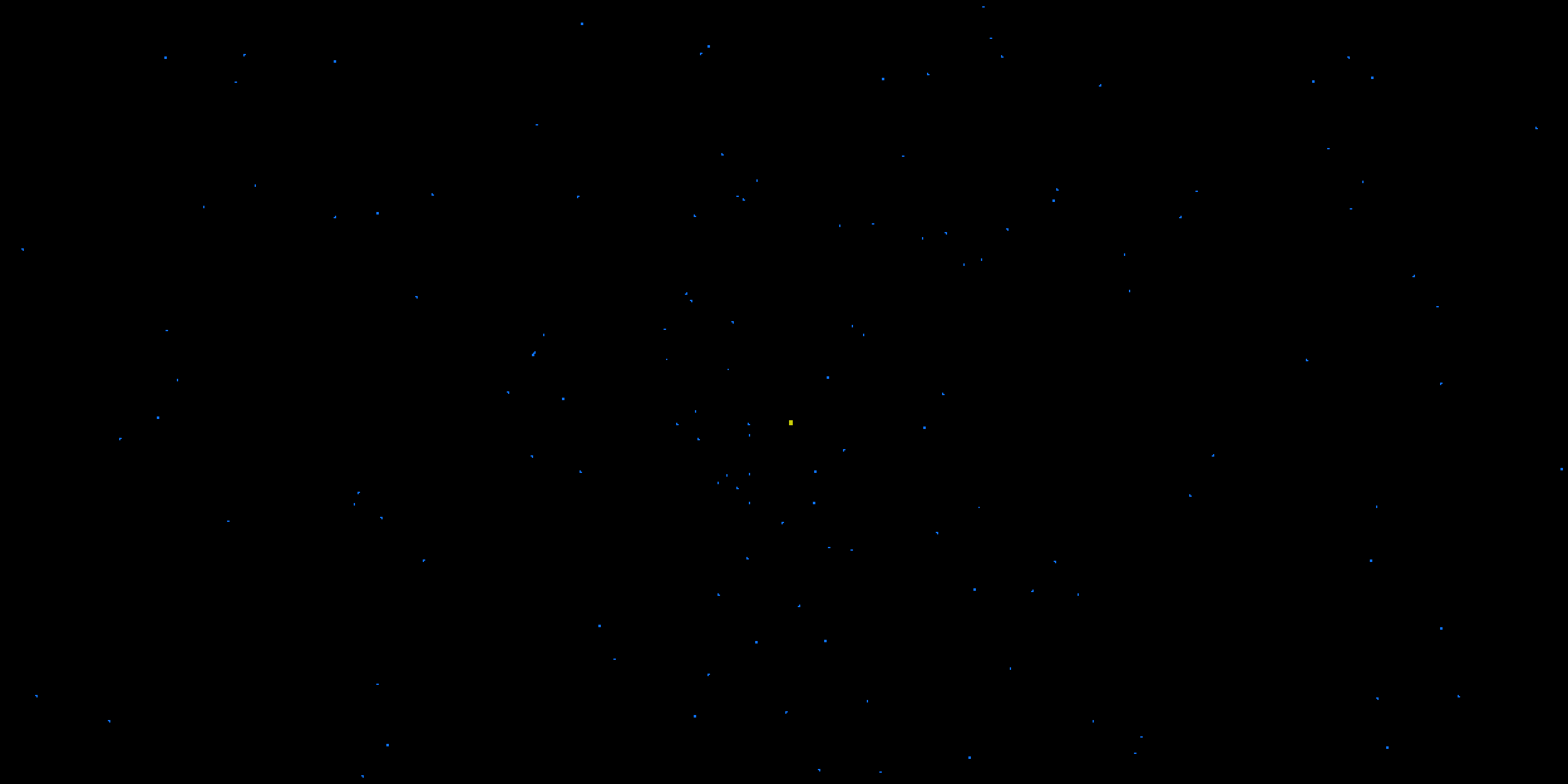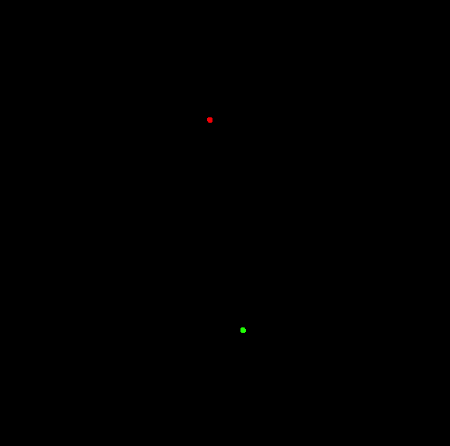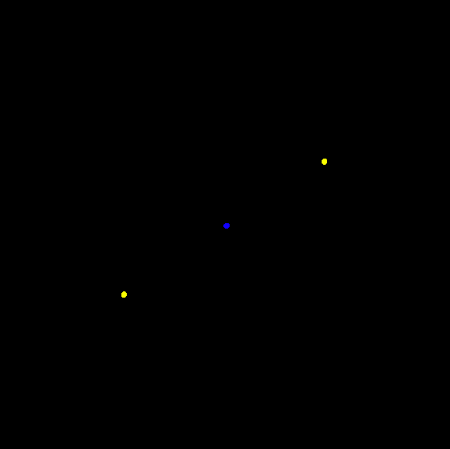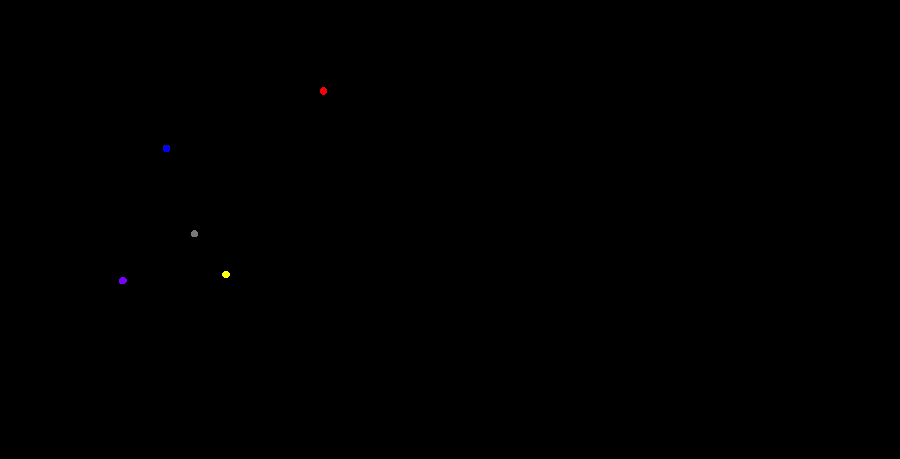Algorithms and visualizations of dynamical systems of bodies influenced by gravity with realistic galaxy interaction models written in Haskell.
- Direct Simulation (O(n^2) algorithm where the force on each particle is calculated by taking every other particle into account)
- Barnes-Hut Simulation (O(n log n)) algorithm based on quad/oct trees currently capable of simulating over 50,000 bodies)
- Galaxy Interaction Models based on Monte-Carlo samplings of the Plummer, Hemquist, and Kuzmin models. This enables us to generate realistic initial conditions for spherical and disk galaxies to model interactions and collisions between them.
 Spherical Galaxy with Plummer Model
Spherical Galaxy with Plummer Model
| Binary Star System | Three Body System |
|---|---|
 |
 |
Barnes-Hut is an efficient, N-body simulation algorithm that allows us to calculate the force on a particular body in O(log n) time as opposed to the O(n), direct-sum algorithm.
It relies on recursively dividing up our space into octants in 3 dimensions or quadrants in 2 dimensions. We keep dividing quadrants into further quadrants until each particle occupies it's own quadrant. All the while maintaining invariant attributes about each partition like center of mass, total mass and position.
| Partitioning the space | Recursive partitioning |
|---|---|
 Image By Eclipse.sx from wikimedia Image By Eclipse.sx from wikimedia |
 Image by Eclipse.sx from wikimedia Image by Eclipse.sx from wikimedia |
This is accoomplished by using a quad/oct tree data-structure to store the data. A Barnes Tree consists of internal and external nodes. Bodies are only stored in external nodes. An external node of the Barnes Tree can contain at most 1 body.
data BarnesTree = Exter !BarnesLeaf
| Inter { cMass :: !Pos
, btCenter :: !Pos
, width :: !Float
, btMass :: !Mass
, nw :: !BarnesTree
, ne :: !BarnesTree
, sw :: !BarnesTree
, se :: !BarnesTree
} deriving (Eq)
data BarnesLeaf = Leaf { blCenter :: !Pos
, blWidth :: !Float
}
| Node { bnCMass :: !Pos
, bnCenter :: !Pos
, bnWidth :: !Float
, blMass :: !Mass
, body :: !Body
} deriving (Show, Eq)We begin by sub-dividing our space into quadrants and inserting our bodies into the Barnes Tree.
insert :: Body -> BarnesTree -> BarnesTreeThere are 3 distinct cases that our insert function has to address:
- Case 1: Inserting a body into an external Leaf node with no bodies
insert b (Exter (Leaf c w)) = Exter (Node (pos b) c w (mass b) b)
- Case 2: Inserting a body into an external node with a body
To do this, we replace the external node with an internal
node, update its attributes and recursively insert the body
into it
insert b1 (Exter (Node cMass c w m b2)) = insert b1 $ insert b2 $ interNode cMass c w m
- Case 3: Inserting a body into an internal Node - Update necessary
To do this, we update the necessary attributes i.e. center
of mass, total mass etc., find which quadrant the body
belongs in and recursively insert the body into one of the
appropriate quadrants:
nw', ne', sw', se'insert b (Inter cMass c w m nw ne sw se) = Inter cMass' c w m' nw' ne' sw' se'
Now that our space and the bodies in it have effectively been inserted into the Barnes Tree, we can utilize its structure to efficiently approximate, upto arbitrary precision, the force each particle experiences due to all the other particles.
force :: Body -> BarnesTree -> AccThere are 3 distinct cases the force calculations have to take into account:
-
Case 1: If the BarnesTree is an external node without a body in it, it exerts no force
force b (Exter (Leaf _ _)) = A 0 0
-
Case 2: If the BarnesTree is an external node with a body in it, we calculate the force exerted by the body in it
force b (Exter n) | b' /= b = f b b' | otherwise = A 0 0 where b' = body n
-
Case 3: If the BarnesTree is an internal node and its (width / distance to particle from center of mass) is less than a configurable quantity,
theta(usually set to0.5), then we can simply treat all of the bodies in that Barnes Tree as a point mass at the center of mass of the tree itself with mass equal to the total mass of the tree. Otherwise, we recursively calculate the force exerted on our body,b, by each of the quadrants.force b (Inter cMass c w m q1 q2 q3 q4) | wd < theta = f b (B m cMass (V 0 0) G.red []) | otherwise = foldr (vSum . force b) (A 0 0) [q1, q2, q3, q4]
- Install dependencies
- Compile and launch, or alternatively run
cabal runorstack build && stack exec
- Realistic spherical and disk galaxies with Plummer, Hernquist and Kuzmin Models to simulate galaxy collisions
- 3D visualization with oct tree Barnes-Hut model
- Parallelize force calculations
- Expanded GUI for selecting initial conditions, changing constants, adding bodies etc.
- Add collision handling
- Add comprehensive test suite
